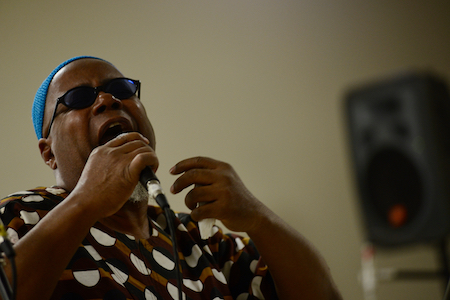Jun 3, 2025 11:25 AM
In Memoriam: Al Foster, 1943–2025
Al Foster, a drummer regarded for his fluency across the bebop, post-bop and funk/fusion lineages of jazz, died May 28…

“A lot of people came through this group, which blew their minds in a way that there was no turning back,” vocalist Dwight Trible said.
(Photo: Chuck Koton)When pianist Horace Tapscott saw a need for more performance opportunities in Los Angeles in 1961, he created the Pan Afrikan Peoples Arkestra, which became a crucial showcase for the city’s jazz composers. Today, the ensemble’s mentors continue to teach, especially around the Leimert Park neighborhood. This year, after COVID-related delays, the Arkestra commemorates its 60th anniversary with the release of a documentary, live performances and a new label that features recordings from its archives alongside the work of younger artists.
“A lot of people came through this group, which blew their minds in a way that there was no turning back,” vocalist Dwight Trible said. “They were enlightened about progressive music and got it by being involved with the Arkestra.”
Trible is the lead voice in a large band of Arkestra veterans called The Gathering, which issued its 2015 performance, Healing Suite, in January. That album is being released through The Village, which is releasing other historic Arkestra-related recordings, as well as works from like-minded musicians. Meanwhile, a new film, The Gathering: Roots & Branches of Los Angeles Jazz, is running in the nationwide film festival circuit. The documentary details a 2005 live recording of the Arkestra, highlighting saxophonist Kamasi Washington as his career began.
“Horace would always bring young and older guys together and have them play side by side, — that’s what I do with The Gathering,” said multi-instrumentalist Jesse Sharps. “In that set, you see older guys like [trombonist] Phil Ranelin, and you see Kamasi [Washington] grow up.”
Tapscott’s vision was equal parts musical and social as he brought the harmonic advances of 1960s free-jazz to his ensemble. The Arkestra also helped shape the city’s burgeoning Black Arts Movement of cultural activism at the time. Keeping a large, community-based organization together through the decades since has brought on numerous challenges, but Tapscott’s vision proved enduring and the Arkestra continued after his death in 1999. That includes ongoing performances at The World Stage, a Leimert Park performance venue that two of his colleagues, drummer Billy Higgins and poet Kamau Daáood, co-founded in 1989.
The Village is also releasing recordings that came from a more hidden source. Drummer Mekala Session is a second-generation Arkestra member; his father, saxophonist Michael Session, played on such landmark Tapscott albums as The Call (1978). The younger Session started sitting in with the band when he was 13. Eventually, Mekala found that Michael, as well as Tapscott, recorded constantly and the results were often found close to home.
“Horace would keep his tape recorder, pop a tape under the piano and go,” Session said. “There was this amazing collection I found behind my living room couch.” After Session showed his friend Jesse Justice his father’s cassettes, they looked for a company to issue the recordings. But, as Session said, “We didn’t get any traction, probably because we were kids. So we decided to do it ourselves.”
These Village recordings are now available through Bandcamp. The company has released a record of Tapscott and Michael Session (Live In Avingon, France 1989) along with Healing Suite. Session and Justice are also releasing new recordings from younger artists, including pianist Jamael Dean’s Ished Tree and saxophonist Randal Fisher’s Everywhere To Be Lost.
The Gathering celebrated its album release with a World Stage concert in January that is currently available for streaming on YouTube. Session is also planning collaborations with artists in other cities, and Daáood insists the future is in that younger generation’s hands.
“New people are stepping in and taking it to another level,” Daáood said. “This organization has been around for 60 years. It does not have a lot of big economic support, just a lot of cats and catresses in the community soaking up the love and giving it back.” DB

Foster was truly a drummer to the stars, including Miles Davis, Sonny Rollins and Joe Henderson.
Jun 3, 2025 11:25 AM
Al Foster, a drummer regarded for his fluency across the bebop, post-bop and funk/fusion lineages of jazz, died May 28…

“Branford’s playing has steadily improved,” says younger brother Wynton Marsalis. “He’s just gotten more and more serious.”
May 20, 2025 11:58 AM
Branford Marsalis was on the road again. Coffee cup in hand, the saxophonist — sporting a gray hoodie and a look of…

“What did I want more of when I was this age?” Sasha Berliner asks when she’s in her teaching mode.
May 13, 2025 12:39 PM
Part of the jazz vibraphone conversation since her late teens, Sasha Berliner has long come across as a fully formed…

Roscoe Mitchell will receive a Lifetime Achievement award at this year’s Vision Festival.
May 27, 2025 6:21 PM
Arts for Art has announced the full lineup for the 2025 Vision Festival, which will run June 2–7 at Roulette…

Benny Benack III and his quartet took the Midwest Jazz Collective’s route for a test run this spring.
Jun 3, 2025 10:31 AM
The time and labor required to tour is, for many musicians, daunting at best and prohibitive at worst. It’s hardly…